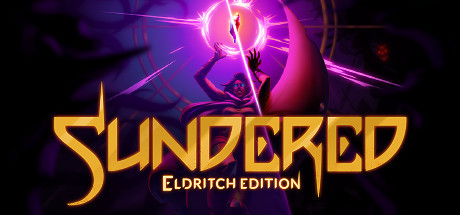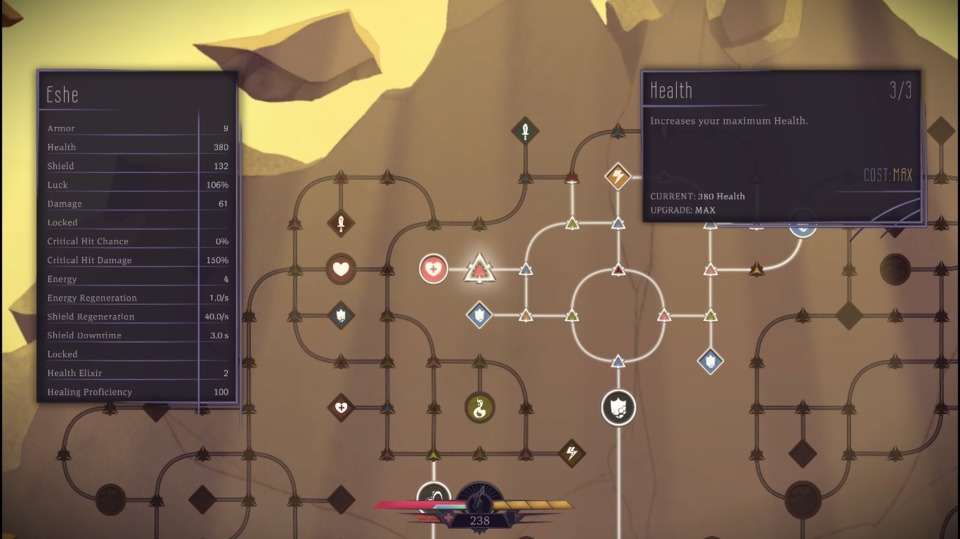Indie Game of the Week 174: Sundered: Eldritch Edition
By Mento 0 Comments

Continuing a mini-series within IGotW I could pragmatically name "free shit I got from the Epic Game Store," Sundered is one of the only games I'm aware of that defines itself as a "roguevania". That is, an explormer game that procedurally generates the majority of its map after every session (or, more accurately, every death). For the record, I've seen this specific hybrid a few times before, albeit without the distinctive genre moniker: Rogue Legacy, for example, will gate you off areas of its dungeon until you've sorted out bosses elsewhere, and randomly generates its hazard-filled fortress every time you move down a generation. However, Sundered's structure is such that it's only partially randomized: certain rooms will always exist in their designated areas on the map, though they're linked together by these larger "blank" map areas that have a random assortment of rooms and pathways through them, including dead ends. Your destination is usually clear, especially as the map helpfully indicates "ability gates" (if not the specific ability you need to surmount them) for you to return to, though the actual routes to them are ambiguous and frequently perilous.
Right off the bat, there are aspects about Sundered that I like and others I like less. We'll cover the former first, since it's the smaller of the two lists. Sundered's combat engine is complex enough that stats play a significant role, though not quite to the extent of an RPG: you can upgrade your total health, armor, stamina, the number of curatives you can carry at once, the number of "perks" you can equip at once, and others. The way you do this is by returning to the hub area of the game and feeding currency - earned from defeating enemies and destroying jars and chests - into an expansive skill tree, with new nodes increasing in price the more of the tree you unlock. Additionally, most of this skill tree is locked away until you have acquired additional traversal abilities, which isn't so much serving to put limits on how powerful you can grow between game milestones than it is to keep this huge skill tree at least somewhat manageable to navigate. While you can walk back or warp to the sanctuary, where this skill tree can be accessed, you're most likely to revisit it immediately after being killed while exploring. As a bit of serendipitous timing, where you're suddenly given the means to greatly enhance your fighting chances after a defeat, it's a neat masterstroke of the game's sense of pacing. You could, theoretically, be so good at the game that you rarely ever have to visit the sanctuary and upgrade, in which case there's no real urgency to do so, but the moment the game starts getting a little unmanageable and finally overwhelms you, the option to make things easier is promptly presented to you. I also think the game looks gorgeous, with a hand-drawn realistic animated style carrying an Asian flair that, as a package, almost resembles Avatar: The Last Airbender. I had to turn down some of the more ostentatious settings, like particle effects, to maintain the stable framerate an action game like this demands, but it's still picturesque as heck and character animations flow beautifully. Likewise the sound design is decent, with the calm ambient background sounds replaced by sirens when shit's about to hit the fan, and a spoken language I'm not entirely sure I can identify (and I suspect is invented for the game).

Then there's all the elements I'm either still gradually warming to, or don't ever see myself appreciating even with more time spent with the game. Naturally, most of this is tied into the game's more roguelite-focused mechanics. Most prominent is the way the game handles enemy encounters: these maps are generally devoid of enemies until you hear that aforementioned siren in the background, at which point it's time to stop whatever exploration or platforming you were doing and stand around clobbering hordes of a very scarce number of enemy types for several minutes. Enemies just flood whichever areas you happen to be standing in when the time arrives, and will persist in chasing you across the zone until you eventually decide to deal with them, which you'll want to do because it's hard to focus on the game's moderately challenging platforming - a whole lot of wall-jumping and trap-evading in particular - when you're getting swamped with very persistent mobs who can all traverse the local environment far easier than you can. Though the combat itself isn't so bad (I appreciate any combat system that has dodge rolls with ample i-frames) it's not all that exciting either, and I find I appreciate it more when the game lets me take in its levels without the interruptions, as tranquil as they are. It reminds me of how Castlevania II for the NES would regularly interrupt whatever you were doing for a dialogue box about curses before making the game a much tougher battle for survival until the morning mercifully arrives: that dialogue box always felt pushy and rude in a weird way, and an unwelcome harbinger of harder times ahead. Really, it's the jarring way that the game goes from a leisurely stroll to this staggering, frantic fracas at the drop of a hat, rather than maintaining a steady mix of combat and platforming throughout like other explormers. I'm also left cold when any procgen is used for level design like this, where environments just come off as samey and nondescript because there aren't any specific level design decisions being made barring those rare templates where they might hide a chest behind a fake ceiling or a floor tile you can jump down. I think back to my time with Bloodstained, and how rooms might have certain little areas that I can't yet reach that I make mental notes to return to, and how satisfying it is to fully chart a specific part of the castle once I have the means to do so. When most of the map is wiped upon death, it feels a little dispiriting to keep starting over, even if I've little reason to return to those early areas.
I can't blame Sundered and its devs (Thunder Lotus Games, also behind the equally pretty but only so-so gameplay-wise Jotun) for doing what it wants to do, which is introduce procgen to explormers in a slightly less intrusive way than it's been done in the past. That there are these "fixture" rooms on the map to head towards, many of which have icons to indicate that a new traversal ability can be acquired or that I've since found the key to get past the obstacle there, means I can still appreciate some sense of progress, as does filling out more of the skill tree when I inevitably lose track of how my health is doing in the midst of a chaotic melee and get booted back to the sanctuary. One smart notion for exploration's sake is how you have a small amount of shield that regenerates after a few seconds; it's usually not enough to rely on to brute force your way past dangerous trap rooms or take a lot of punishment when you're completely swamped with enemies, but it's enough that you don't feel like the game is whittling down your health bar constantly. If you're cautious enough, and use the dodge roll judiciously, you'll probably emerge from most enemy encounters without a scratch, and the shield is one of many aspects of your character development that you can improve through the skill tree. I haven't died nearly as much as I make it sound like I do, and the first time it happened was only because I accidentally triggered that most debilitating of status effects: Windows's regrettable "Sticky Keys" tool that booted me out of the game to deal with it, which I've since finally disabled for good. Other issues, like the difficulty of getting any controller to play nice with the game, is mostly on me and my lack of resourcefulness when it comes to solving technical issues. I don't think I'll throw in the towel on Sundered just yet as I feel I've almost matched the beat of its peculiar rhythm, but I can't say I'm fully sold on its approach to hybridizing these two popular Indie genres either.
Rating: 3 out of 5 (so far).
| < Back to 173: Fell Seal: Arbiter's Mark | The First 100 | > Forward to 175: Blossom Tales: The Sleeping King |
